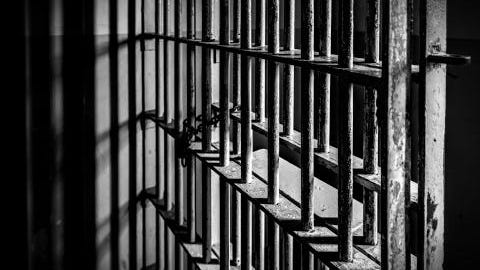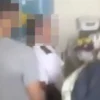
Isaac Scott has an unconventional resume. As a young man (born and raised) in Harlem, NY, searching for a father figure, he turned to drug dealing and street life. He cycled through home, streets and school until he gained his associate’s in 2004, but could not afford the small cost for his cap and gown. Frustrated, hurt, he turned back to the streets and spent 9 years in prison, where he learned vocational trades but was also introduced to visual art as a means of financial sustenance and emotional coping. When he left prison in 2014, he founded an arts and advocacy group called Isaac’s Quarterly, majored in Visual Arts at Columbia University, became an ordained minister and is currently working toward his masters of divinity in youth and family ministries at Liberty University.
This is how Scott came to us, the dozen or so attendees of his Transformative Arts Engagement for Justice and Economic Empowerment workshop on March 23. It was a snowy day and the black floors of the Schwartz Center’s Black Box Theatre were striped with salt and melted snow. Scott stood in front of us, moving up and down along the length of the stage, and thanked us for making the trek in the snow.
Scott’s workshop was a diverse toolkit of ways to lead arts sessions and engage with artmakers in carceral settings. He guided us through the three levels of listening, how not to retraumatize inmates during the creative process and how to end sessions with a decompression activity. But what still rings in my head weeks after the workshop — and what resonates in my Arts in Incarceration course with Prof. Bruce Levitt, PMA, who helped organize the workshop — is the notion of carceral arts as a tool to manipulate and reimagine the prison space. When practiced by inmates, the arts — visual, written, theatrical — take on an almost resistant aspect; they answer prisons’ way of dehumanizing inmates and constricting imagination with a cry of personality and a belief in the possible.
In a book assigned for the Arts in Incarceration course, Theatre and Prisons, Caoimhe McAvinchey describes a performance of Une Nuit de Noël at San Quentin prison in 1913. The performance was “an act of disruption which challenges concepts of time, space and the materiality of the prison world. … The prison yard, usually a site of association and exercise, becomes … an outdoor theatre space where the certainty of prison life is ruptured and previously unimagined worlds are offered. … [T]he prison yard will no longer be just the prison yard: it will be configured as a place of other possibilities.”
In Nicole R. Fleetwood’s Marking Time, we see another take on this phenomenon: “Through artistic practices and creative communities inside prison, incarcerated artists fight the punitive isolation and severance of relationships that prisons impose. They work to undermine the carceral indexes, meaning the data and records — like mug shots — that mark people as criminal and incarcerated subjects, and the stigma of being a prisoner. Prison art is part of the long history of captive people envisioning freedom — creating art, imagining worlds, and finding ways to resist and survive.”
During the screening of Scott’s film Before Time/After Time that followed the workshop, I saw yet another aspect of the arts’ transformative qualities. In the film, returned incarcerated folks read poetry and letters they’d written to themselves and their family members as a means of grappling with their crimes.
Leaderboard 2
In a letter to his mother, one man detailed the path he took toward a rough crowd that resulted in his killing someone. With deep emotion, he asked — even begged — forgiveness from her even as he mourned her death from multiple sclerosis. He described how her perseverance inspired and gave him hope on his journey toward redemption.
Another woman wrote a letter-poem entitled “Dear People I Have Hurt” wherein she claimed responsibility for the lives her actions have impacted — both from and beyond her criminal activity — and asked for their forgiveness.
Here, the writing of these formerly incarcerated folks complicates traditional narratives of the imprisoned as irredeemable, unforgivable, broken in ways that can never be repaired. We see not only their ability to grapple with and perhaps even learn to live with their pasts, but also their ability to practice a deep level of emotional intelligence. This is what happens when we trust the incarcerated to tell their own stories — they surprise us, who scorned them as unfeeling, insensate; they become human, having made irretrievable mistakes but still worthy of our love and respect.
Newsletter Signup
For incarcerated artists, the practice of artmaking might make the realities of prison more bearable — it is a flash of light and creative inspiration in the otherwise bleak landscape of the prison space. For us in the public, it reminds us of the incontrovertible — though often repressed — humanity of incarcerated folks. It reminds us to think of them as full beings, perfect and imperfect, scarred as we are.
At the close of the workshop, Scott passed out sheets of paper and asked us to draw visual responses to this question: “What does public safety look like with no jails, no prison, and no punishment?” The people sitting around me drew hearts radiating from blobby bodies, stick figures holding hands, friends working in a community garden. I drew a neighborhood with a central square and a fountain, a grocery store, a house of worship, a library, a bank. I realized that in that moment, Scott asked us to do what inmates do directly and indirectly when they practice art in prison: to dream beyond the gray walls of our lives, to manipulate our spatial reality, to imagine a better and more liveable world.
Finley Williams is a junior in the College of Arts and Sciences. She can be reached at [email protected]. Kaleidoscope runs alternate Tuesdays.
This post was originally published on this site be sure to check out more of their content.













